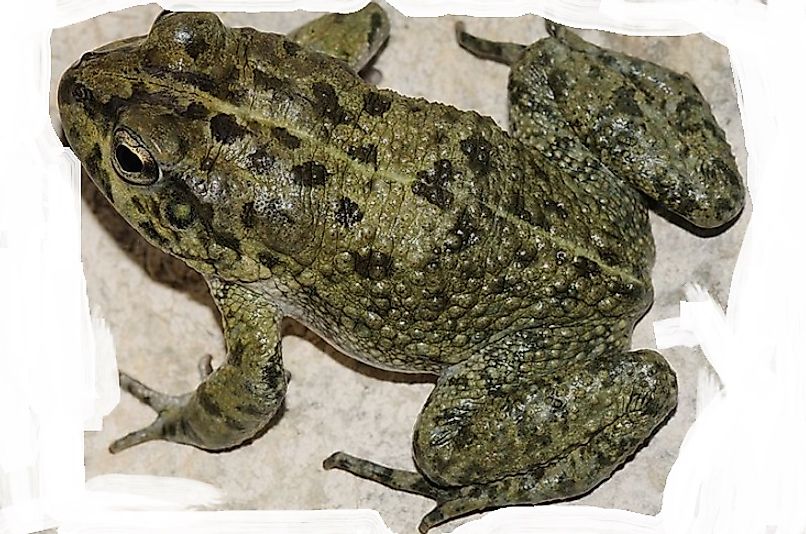Amphibians Of Saudi Arabia

Saudi Arabia's oases and coastal and riverine wetlands house a unique mix of frogs and toads. Seven species of amphibians inhabit Saudi Arabia. Four of these species are endemic to Saudi Arabia. Namely, these are the Dhofar toad (Bufo dhurefencis), Yemeni toad (Bufo tihamicus), Arabian toad (Bufo arabicus), and the Arabian five-fingered frog (bufo euphlyctus). The remaining three also inhabit other regions as well, and they are the European Greek toad (Bufo viradid), the Middle East tree frog (Hyla savignyi), and the marsh frog (pelophylax ridibundus)
Amphibians Of Saudi Arabia
Dhofar Toad (Bufo dhuferencis)
The Dhofar toad (Bufo dhuferencis) is also known as the ‘Oman toad.’ The toad is small in size and varies in appearance as some can be brown, light green and speckled. They have bulging eyes and a large tympanum. The toad lays eggs which hatch into tadpoles. The tadpoles develop very fast just before the water body dries up and moves into the land. The toad is nocturnal and feeds on insects. During the drought, it buries itself in the ground for up to three years. During rainy seasons it emerges from its hibernation and goes to water bodies for mating. When it senses danger, it turns into a bright color to scare the prey away. Dhofar toad mostly occupies places with water bodies or damp areas. It lives near springs, pools, dams, rivers, and oasis. The Dhofar toad is listed under the amphibians that are least concern as currently it does not face the threat of extinction. It has great hibernating modification thus can survive the worst of times.
Arabian Toad (Bufo arabicus)
The Arabian toad is found in the southwestern regions of Saudi Arabia near Makka. The toad's head is round with prominent eyes and has small tympanic membranes. They vary in color. They can be gray, tan brown or green. It inhabits places near water sources such as springs, oases, and irrigation channels. In Saudi Arabia, it is in Al-Aflaj in central Saudi Arabia. The toad can be active any time of the day or night. It feeds on insects and small invertebrates. Larger toads at times can eat smaller toads. It also feeds on smaller fish in water bodies that are drying up. It breeds any time of the year in slow moving water. It hibernates by burying itself into the ground until it rains. It can stay in the ground for up to three years. During this time it breathes using the skin. During rains, several of them emerge and converge in suitable places to breed. The toad breeds in areas far away from human disturbance and has very high adaptation capabilities hence are not threatened. They are also massive in numbers with no projections of population decline.
Marsh Frog (Pelophylax ridibundus)
The Marsh Frog is large and can reach lengths of up to 17 centimeters. They range in color and can be either dark green or gray. The most common are green hence generally referred to as the green frog. They have a large head with long hind feet. Long feet help them to jump. They can be either striped or spotted. It stays in water bodies with a temperature of 15 degrees Celsius. In Saudi Arabia, it is found in such areas as Al-Hasa in the southeastern part of Saudi Arabia. The life cycle of the marsh frog follows the same cycle of amphibians. They lay eggs in water in frogspawn. The eggs hatch into tadpoles. After some time the tadpoles grow into adult toad shape though smaller in size and adopt either the strips or the sports. The toad mainly feeds on dragonflies and such other small invertebrates as spiders, earthworms, and slugs. The larger frogs can eat small rodents and fish. They hibernate during adverse seasons. Hibernation is mostly in water bodies, but they can also hibernate in holes and burrows in river banks and shores of lakes.
Yemeni Toad (Bufo tihamicus)
The Yemeni toad species belongs to the family Bufonidae, and is most often found in Yemen and Saudi Arabia. The natural habitats of the toad include tropical dry shrub lands, subtropical irrigated lands and other arable lands, and around rivers. This amphibian has littoral habitats of up to 400 meters above sea level, mainly along the coastline of the Red Sea and the Arabian Peninsula. The toad can be found in arid vegetation and where there are water sources, except in riparian vegetation close to wadis. They breed in shallow water and slow moving water. They live in freshwater and terrestrial systems, and there are no threats to these toads. They are listed as least concern because they have wide distributions and tolerate habitat modification.
Limited Habitats for Saudi Arabia's Amphibians
Saudi Arabia is the world’s largest country to lack a river. Most amphibians are found around the water sources, but thanks to the extensive coastline along the Red Sea and the Persian Gulf where most of the amphibians in the country are found. There are seven species of Amphibians in the country, and none is facing serious threats because of their adaptation to a wide range of environments and modified habitat.
Amphibians Of Saudi Arabia
| Amphibians of Saudi Arabia | Binomial Scientific Name |
|---|---|
| Arabian Toad | Bufo arabicus |
| Dhofar Toad | Bufo dhufarensis |
| Yemeni Toad | Bufo tihamicus |
| Arabian Five-Fingered Frog | Euphlyctis ehrenbergii |
| European Green Toad | Bufo viridis |
| Middle East Tree Frog | Hyla savignyi |
| Marsh Frog | Pelophylax ridibundus |







